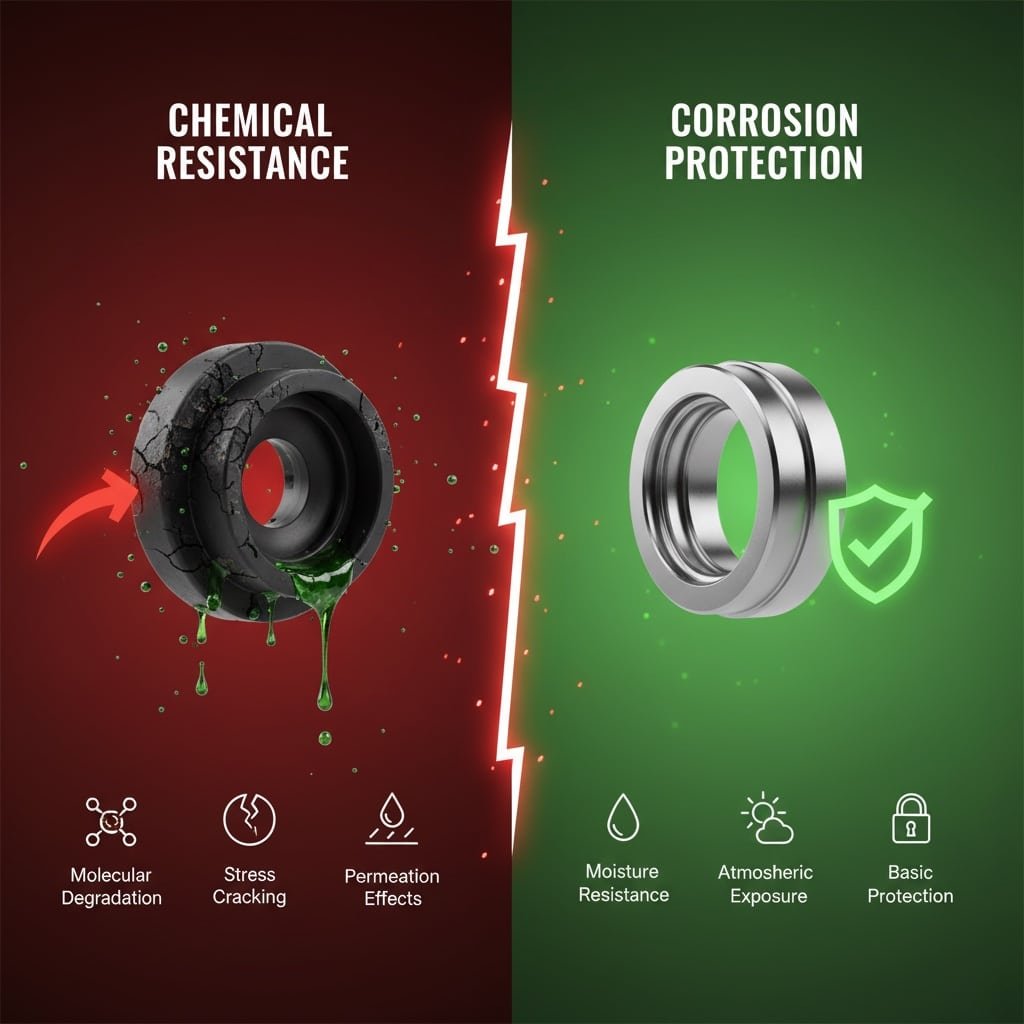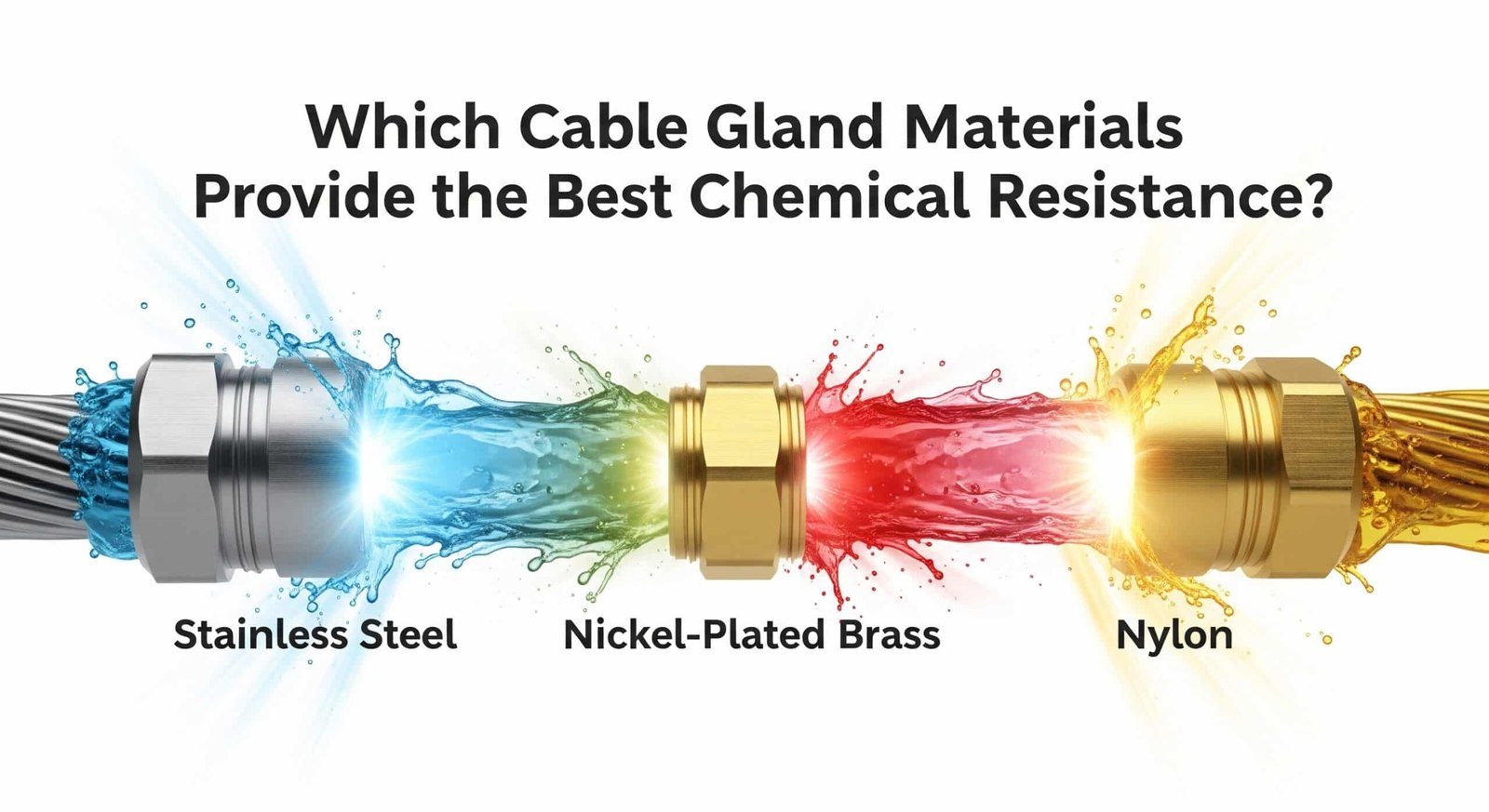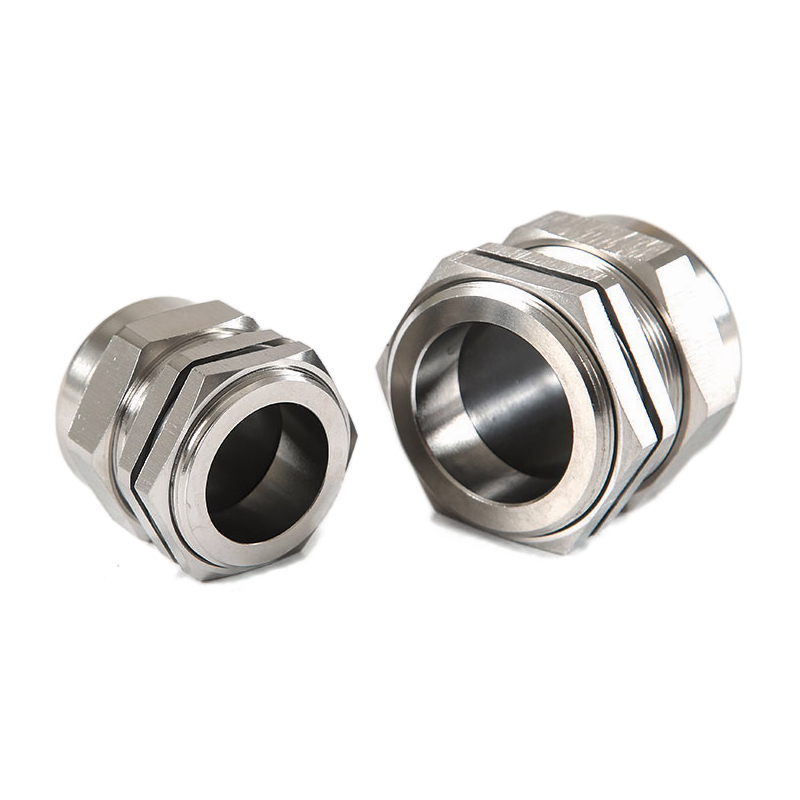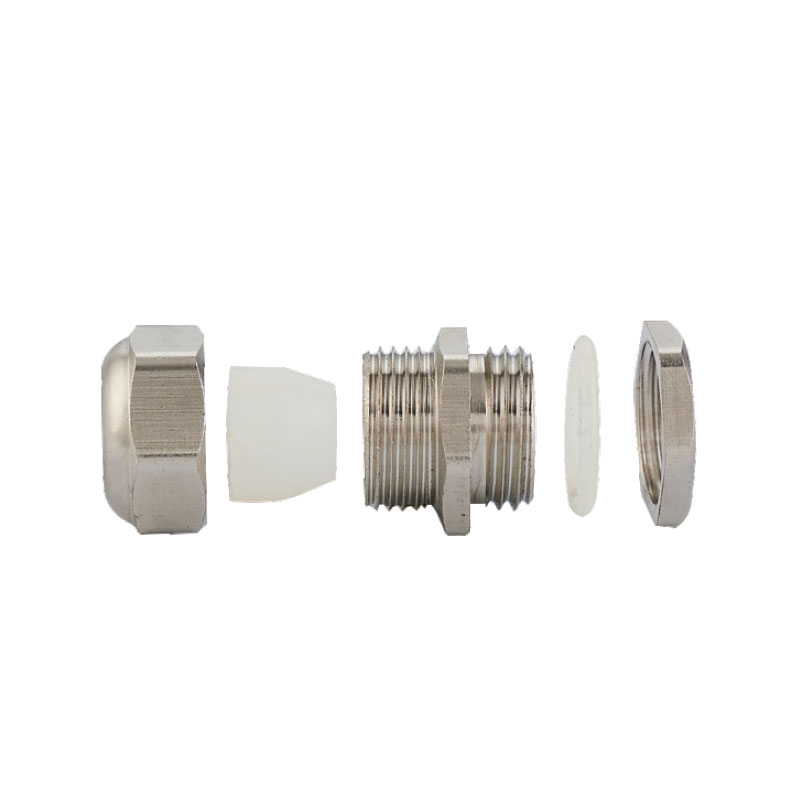Chemical processing facilities lose millions annually due to cable gland failures caused by inadequate material selection, with corrosive environments destroying standard components within months and creating safety hazards, production downtime, and costly emergency repairs. Many engineers underestimate the aggressive nature of industrial chemicals and select cable glands based on price rather than chemical compatibility, leading to catastrophic failures that compromise both safety and profitability.
Kelenjar kabel tahan bahan kimia memerlukan bahan khusus termasuk PTFE, elastomer FFKM, Hastelloy, dan baja tahan karat 316L yang dapat menahan paparan bahan kimia tertentu, rentang suhu, dan tingkat konsentrasi sambil mempertahankan integritas penyegelan dan kekuatan mekanis selama periode servis yang lama. The right material selection prevents corrosion-induced failures and ensures reliable performance in harsh chemical environments.
Having worked with chemical processors, pharmaceutical manufacturers, and petrochemical facilities across North America, Europe, and the Middle East—from refineries in Texas to chemical plants in Germany—I’ve seen how proper material selection directly impacts safety, reliability, and total cost of ownership. Let me share the critical knowledge every engineer needs for selecting chemical-resistant cable glands.
Daftar Isi
- What Makes Chemical Resistance Different from Standard Corrosion Protection?
- Which Materials Offer Superior Chemical Resistance for Cable Glands?
- How Do You Match Materials to Specific Chemical Environments?
- What Are the Key Performance Factors Beyond Chemical Compatibility?
- How Do You Validate Material Selection for Long-Term Reliability?
- FAQs About Chemical Resistant Cable Gland Materials
What Makes Chemical Resistance Different from Standard Corrosion Protection?
Chemical resistance requires materials that maintain structural integrity and sealing effectiveness when exposed to specific chemicals at various concentrations and temperatures, while standard corrosion protection only addresses general atmospheric exposure and basic moisture protection.
Understanding these differences is crucial because materials that perform well in standard industrial environments often fail catastrophically in chemical processing applications.

Chemical Attack Mechanisms
Molecular Degradation: Aggressive chemicals can break down polymer chains at the molecular level, causing swelling, cracking, or complete dissolution of sealing materials within hours or days.
Stress Cracking1: Chemical exposure combined with mechanical stress can cause brittle failure in materials that appear chemically compatible under unstressed conditions.
Permeation Effects: Some chemicals penetrate through seemingly resistant materials, causing internal degradation or contaminating sealed environments over time.
Synergistic Effects: Multiple chemicals or chemical mixtures can create attack mechanisms that don’t occur with individual chemical exposure, requiring comprehensive compatibility testing.
Temperature and Concentration Dependencies
Elevated Temperature Effects: Chemical attack rates typically increase exponentially with temperature, making high-temperature chemical resistance particularly challenging to achieve.
Concentration Sensitivity: Material compatibility often varies dramatically with chemical concentration, requiring specific testing at actual operating concentrations.
Tekanan Bersepeda Termal: Repeated heating and cooling in chemical environments creates additional stress that can accelerate material degradation beyond static exposure effects.
pH Sensitivity: Acidic and basic environments require different material approaches, with pH levels affecting compatibility even for the same base chemicals.
I remember working with Jennifer, a maintenance manager at a major chemical processing facility in Louisiana. Her plant initially used standard nylon cable glands throughout their sulfuric acid production area to control costs. Within six months, multiple gland failures caused equipment shutdowns and safety incidents when acid vapors attacked the nylon components. After upgrading to our PTFE-lined stainless steel cable glands specifically designed for acid service, the facility has operated for over four years without a single chemical-related gland failure. The material upgrade eliminated costly emergency repairs and improved overall plant safety. 😊
Long-Term Performance Requirements
Service Life Expectations: Chemical processing facilities typically require 10-20 year service life from cable glands, demanding materials with proven long-term chemical stability.
Aksesibilitas Pemeliharaan: Many chemical installations have limited maintenance windows, making initial material selection critical for avoiding unplanned shutdowns.
Safety Compliance: Chemical-resistant materials must maintain performance to prevent leaks that could create safety hazards or environmental violations.
Economic Impact: Material failures in chemical environments often trigger cascading problems including equipment damage, production losses, and regulatory penalties.
Which Materials Offer Superior Chemical Resistance for Cable Glands?
PTFE and FFKM provide the broadest chemical resistance, Hastelloy and Inconel offer high-temperature chemical compatibility, while specialized polymers like PEEK and PPS provide cost-effective solutions for specific chemical families and operating conditions.
Material selection depends on balancing chemical compatibility requirements with mechanical properties, temperature limits, and cost considerations.
Fluoropolymer Solutions
PTFE (Polytetrafluoroethylene)2: Offers exceptional chemical resistance to virtually all chemicals except molten alkali metals and elemental fluorine, with operating temperatures up to 260°C.
FFKM (Perfluoroelastomer): Combines PTFE-level chemical resistance with elastomeric properties for dynamic sealing applications, ideal for high-temperature chemical service.
FEP and PFA: Provide similar chemical resistance to PTFE with improved processability and mechanical properties for complex gland geometries.
ETFE: Offers excellent chemical resistance with superior mechanical strength and radiation resistance for nuclear and pharmaceutical applications.
High-Performance Metal Alloys
Hastelloy C-2763: Provides outstanding resistance to oxidizing and reducing chemicals, chlorides, and mixed acid environments at elevated temperatures.
Inconel 625: Offers excellent resistance to organic acids, chloride environments, and high-temperature oxidizing conditions in chemical processing.
Baja Tahan Karat 316L: Provides good general chemical resistance for mild to moderate chemical environments at reasonable cost with proven reliability.
Paduan Titanium: Deliver exceptional resistance to chlorine, chlorides, and oxidizing acids while maintaining high strength-to-weight ratios.
Specialized Engineering Polymers
MENGINTIP (Polietereterketon)4: Combines excellent chemical resistance with high-temperature capability and superior mechanical properties for demanding applications.
PPS (Polifenilena Sulfida): Offers broad chemical resistance with excellent dimensional stability and electrical properties for electronic applications.
PVDF (Polyvinylidene Fluoride): Provides good chemical resistance with excellent UV stability and mechanical properties for outdoor chemical installations.
CPVC (Chlorinated PVC): Delivers cost-effective chemical resistance for chlorinated compounds and many acids at moderate temperatures.
Matriks Pemilihan Bahan
| Chemical Family | Bahan Utama | Opsi Sekunder | Temperature Limit | Faktor Biaya |
|---|---|---|---|---|
| Strong Acids | PTFE/FFKM | Hastelloy C-276 | 200°C | 3-5x |
| Strong Bases | PTFE/FFKM | Inconel 625 | 150°C | 3-5x |
| Organic Solvents | FFKM | MENGINTIP | 180°C | 2-4x |
| Chlorinated Compounds | PTFE | CPVC | 120°C | 2-3x |
| Mixed Chemicals | PTFE/FFKM | Hastelloy C-276 | 200°C | 4-6x |
Validasi Kinerja: All material selections should be validated through actual exposure testing rather than relying solely on generic chemical resistance charts.
Optimalisasi Biaya: Consider total cost of ownership including maintenance, downtime, and replacement costs rather than just initial material cost.
How Do You Match Materials to Specific Chemical Environments?
Material matching requires analyzing chemical compatibility data, operating conditions, mechanical requirements, and long-term performance expectations while considering synergistic effects, impurities, and process variations that affect material selection decisions.
Proper matching prevents costly failures and ensures reliable long-term performance in chemical processing applications.
Chemical Compatibility Analysis
Compatibility Charts: Use detailed chemical resistance charts that specify concentration ranges, temperature limits, and exposure conditions for accurate material selection.
Immersion Testing: Conduct actual immersion testing with process chemicals at operating conditions to validate theoretical compatibility data.
Pengujian Stres: Evaluate material performance under combined chemical exposure and mechanical stress to identify potential failure modes.
Impurity Effects: Consider the impact of trace chemicals, catalysts, and process impurities that may not appear in standard compatibility charts.
Operating Condition Considerations
Temperature Profiles: Analyze both steady-state and transient temperature conditions, including startup, shutdown, and emergency scenarios.
Persyaratan Tekanan: Consider pressure cycling effects on material compatibility, as pressure can accelerate chemical attack mechanisms.
Flow Conditions: Evaluate the impact of chemical flow rates, turbulence, and erosion potential on material selection and gland design.
Atmospheric Exposure: Account for vapor phase chemical exposure in addition to direct liquid contact for comprehensive material evaluation.
Process-Specific Requirements
Cleaning Protocols: Consider compatibility with cleaning chemicals, sanitizers, and sterilization procedures used in maintenance operations.
Product Contamination: Evaluate potential for material degradation products to contaminate process streams in food, pharmaceutical, or electronic applications.
Fire Safety: Assess material behavior in fire conditions, including flame spread, smoke generation, and toxic gas emission characteristics.
Kepatuhan terhadap Peraturan: Ensure selected materials meet industry-specific regulations for food contact, pharmaceutical manufacturing, or hazardous area classifications.
Multi-Chemical Environments
Synergistic Effects: Test material compatibility with actual chemical mixtures rather than individual components to identify unexpected interactions.
Sequential Exposure: Evaluate materials exposed to different chemicals in sequence, as previous exposure can affect subsequent chemical resistance.
Concentration Variations: Consider the impact of varying chemical concentrations throughout process cycles on long-term material stability.
pH Fluctuations: Account for pH variations that can dramatically affect material compatibility even with the same base chemicals.
Marcus, who manages a pharmaceutical manufacturing facility in Basel, Switzerland, faced challenges with cable gland failures in their multi-product facility where different chemicals were used for various drug formulations. Standard chemical resistance charts didn’t account for the sequential exposure to different solvents and cleaning agents. After working with our technical team to develop a comprehensive testing protocol using actual process chemicals and cleaning sequences, we identified FFKM as the optimal material. The specialized testing approach prevented costly production interruptions and ensured regulatory compliance across all product lines.
What Are the Key Performance Factors Beyond Chemical Compatibility?
Beyond chemical resistance, cable glands must maintain mechanical strength, electrical properties, sealing effectiveness, and dimensional stability while providing adequate service life, cost-effectiveness, and compliance with safety regulations in chemical processing environments.
Comprehensive performance evaluation ensures reliable operation across all critical parameters, not just chemical compatibility.
Mechanical Property Requirements
Kekuatan Tarik: Chemical-resistant materials must maintain adequate tensile strength throughout their service life to handle cable pulling forces and thermal stresses.
Creep Resistance: Long-term dimensional stability under constant load prevents seal relaxation and maintains compression sealing effectiveness.
Ketahanan terhadap benturan: Materials must withstand mechanical impact from maintenance activities, thermal shock, and process upsets without brittle failure.
Fatigue Resistance: Repeated pressure cycling, thermal cycling, and vibration require materials with excellent fatigue resistance for long-term reliability.
Karakteristik Kinerja Listrik
Kekuatan Dielektrik5: Insulating materials must maintain electrical properties when exposed to chemicals that could cause swelling or property changes.
Persyaratan Konduktivitas: Metallic components must maintain electrical continuity for grounding and EMC applications despite chemical exposure.
Tracking Resistance: Surface contamination from chemical exposure must not create conductive paths that compromise electrical safety.
Arc Resistance: Materials must resist electrical arc damage in environments where chemical vapors could create explosive atmospheres.
Sealing Performance Factors
Set Kompresi: Elastomeric sealing materials must resist permanent deformation when compressed in chemical environments over extended periods.
Gas Permeability: Chemical exposure can affect gas barrier properties, potentially compromising pressure integrity or allowing contamination.
Ekspansi Termal: Differential thermal expansion between materials must be managed to maintain sealing effectiveness across temperature ranges.
Surface Compatibility: Sealing surfaces must resist chemical attack that could create leak paths or compromise sealing effectiveness.
Long-Term Reliability Considerations
Karakteristik Penuaan: Materials must resist degradation from UV exposure, oxidation, and thermal aging in addition to chemical exposure.
Persyaratan Pemeliharaan: Consider accessibility for inspection, testing, and replacement in chemical environments with limited maintenance windows.
Spare Parts Availability: Ensure long-term availability of replacement components for critical applications with extended service life requirements.
Persyaratan Dokumentasi: Maintain detailed records of material specifications, test results, and performance history for regulatory compliance and troubleshooting.
How Do You Validate Material Selection for Long-Term Reliability?
Material validation requires accelerated aging tests, real-world exposure studies, comprehensive performance monitoring, and systematic documentation to ensure selected materials will provide reliable service throughout their expected lifetime in specific chemical environments.
Proper validation prevents costly field failures and provides confidence in material selection decisions for critical applications.
Accelerated Testing Protocols
Chemical Immersion Testing: Extended exposure testing at elevated temperatures and concentrations accelerates aging effects and reveals long-term compatibility issues.
Tes Siklus Termal: Combined chemical exposure and thermal cycling reveals material behavior under realistic operating conditions.
Mechanical Stress Testing: Testing under combined chemical exposure and mechanical stress identifies potential failure modes not apparent in unstressed conditions.
UV and Weathering Tests: Outdoor chemical installations require materials that resist both chemical attack and environmental degradation.
Field Validation Methods
Pilot Installations: Small-scale field trials provide real-world validation of material performance under actual operating conditions.
Pemantauan Kinerja: Systematic monitoring of material condition, sealing effectiveness, and mechanical properties throughout service life.
Analisis Kegagalan: Detailed analysis of any material failures to understand root causes and improve future material selection.
Comparative Studies: Side-by-side comparison of different materials in identical service conditions provides reliable performance data.
Dokumentasi dan Penelusuran
Sertifikasi Material: Maintain complete documentation of material specifications, certifications, and test results for regulatory compliance.
Catatan Instalasi: Document installation procedures, torque specifications, and initial performance measurements for future reference.
Maintenance History: Track inspection results, performance changes, and replacement schedules to optimize maintenance programs.
Performance Database: Build institutional knowledge through systematic collection and analysis of material performance data.
Program Penjaminan Mutu
Inspeksi Masuk: Verify material properties and certifications for all chemical-resistant components before installation.
Periodic Testing: Establish schedules for periodic material testing and inspection based on service conditions and regulatory requirements.
Kualifikasi Pemasok: Maintain qualified supplier lists with documented performance history and quality system certifications.
Kontrol Perubahan: Implement formal procedures for evaluating and approving material changes to prevent unintended performance impacts.
Hassan, who owns a specialty chemical production facility in Dubai, UAE, learned the importance of comprehensive validation during a facility expansion. His engineering team initially selected materials based on generic chemical resistance charts without considering the specific combination of chemicals, temperatures, and process conditions in their facility. After implementing our comprehensive validation protocol including accelerated testing with actual process chemicals and pilot installation monitoring, they identified several materials that would have failed prematurely. The thorough validation process prevented potential safety incidents and production disruptions worth millions in lost revenue.
Kesimpulan
Selecting chemical-resistant cable gland materials requires understanding the fundamental differences between chemical resistance and standard corrosion protection, evaluating comprehensive material properties beyond just chemical compatibility, and implementing thorough validation protocols to ensure long-term reliability. Success depends on matching materials to specific chemical environments while considering mechanical, electrical, and sealing performance requirements.
The key to reliable chemical-resistant installations lies in taking a systematic approach that combines theoretical knowledge with practical testing and real-world validation. At Bepto, we provide comprehensive chemical-resistant cable gland solutions including material selection guidance, application testing, and technical support to help customers achieve reliable performance in the most demanding chemical environments. Our engineering team understands the complex relationships between chemical compatibility, mechanical properties, and long-term reliability that determine success in chemical processing applications.
FAQs About Chemical Resistant Cable Gland Materials
T: Bahan apa yang terbaik untuk lingkungan asam kuat?
A: PTFE atau FFKM memberikan ketahanan terbaik terhadap asam kuat termasuk asam sulfat, klorida, dan nitrat pada berbagai konsentrasi dan suhu. Fluoropolimer ini menjaga integritas di mana bahan lain akan larut atau terdegradasi dengan cepat.
T: Dapatkah kelenjar kabel baja tahan karat menangani semua lingkungan kimia?
A: Standard 316L stainless steel handles many chemicals but fails in chloride-rich, strong acid, or high-temperature oxidizing environments. Specialized alloys like Hastelloy C-276 or Inconel 625 are required for aggressive chemical service.
T: Bagaimana cara menguji kompatibilitas bahan kimia sebelum pemasangan?
A: Conduct immersion testing with actual process chemicals at operating temperature and concentration for extended periods. Generic compatibility charts provide guidance, but actual testing with your specific chemicals and conditions is essential for critical applications.
Q: What’s the difference between chemical resistance and corrosion resistance?
A: Chemical resistance addresses specific chemical attack mechanisms at molecular level, while corrosion resistance typically refers to general atmospheric exposure and moisture protection. Chemical resistance requires much more specialized materials and testing protocols.
Q: How long do chemical-resistant cable glands typically last?
A: Service life varies from 5-20 years depending on material selection, chemical exposure severity, and operating conditions. PTFE and FFKM materials typically provide the longest service life in aggressive chemical environments, while specialized polymers may require more frequent replacement.
-
Learn about the combined effects of chemical exposure and mechanical stress that can lead to brittle failure in materials. ↩
-
Explore the detailed chemical, thermal, and mechanical properties of Polytetrafluoroethylene. ↩
-
View technical specifications and typical applications for this high-performance, corrosion-resistant nickel alloy. ↩
-
Discover the high-temperature capabilities and broad chemical resistance of Polyetheretherketone. ↩
-
Understand this critical electrical insulation property and how it is measured. ↩




